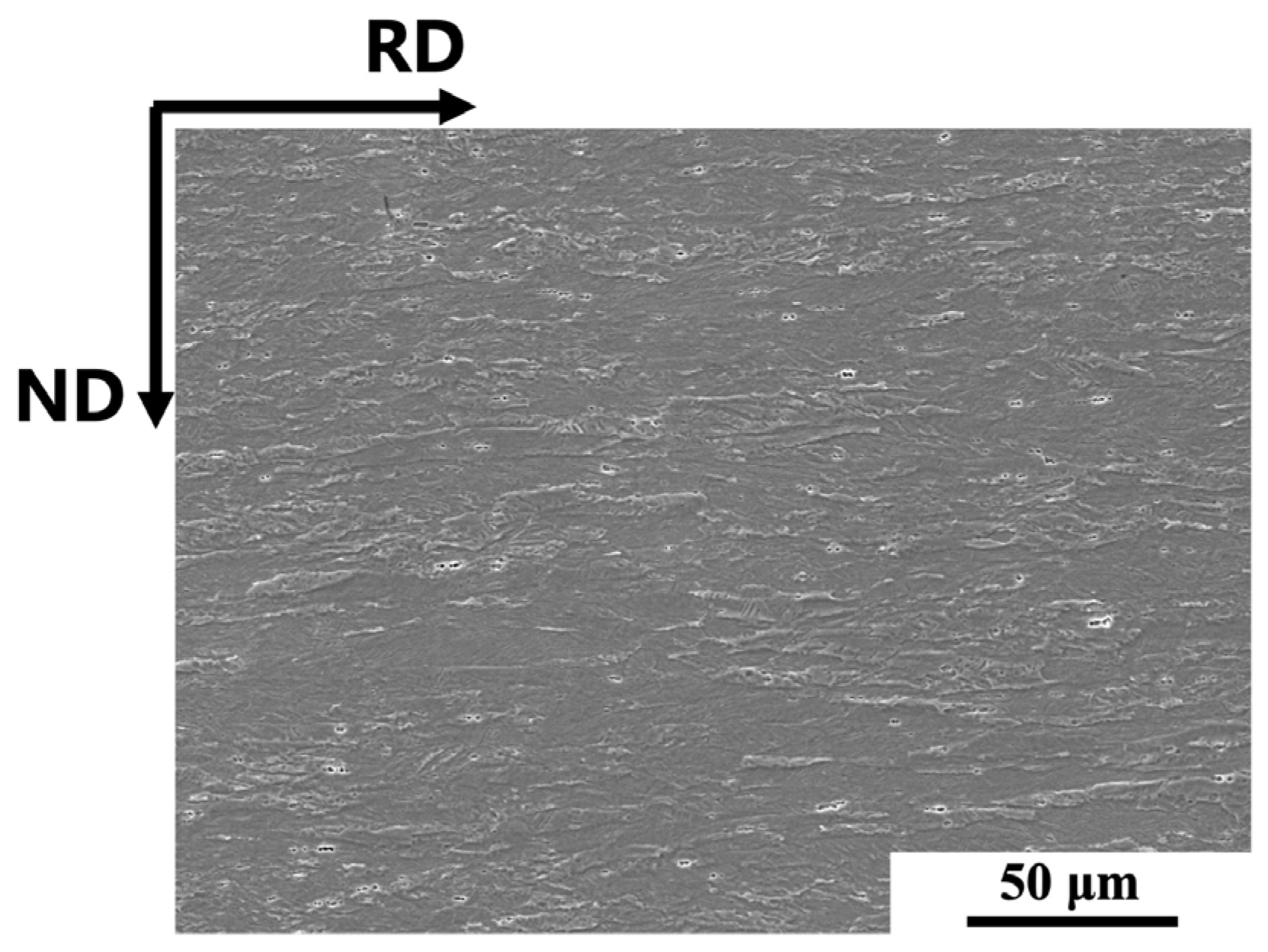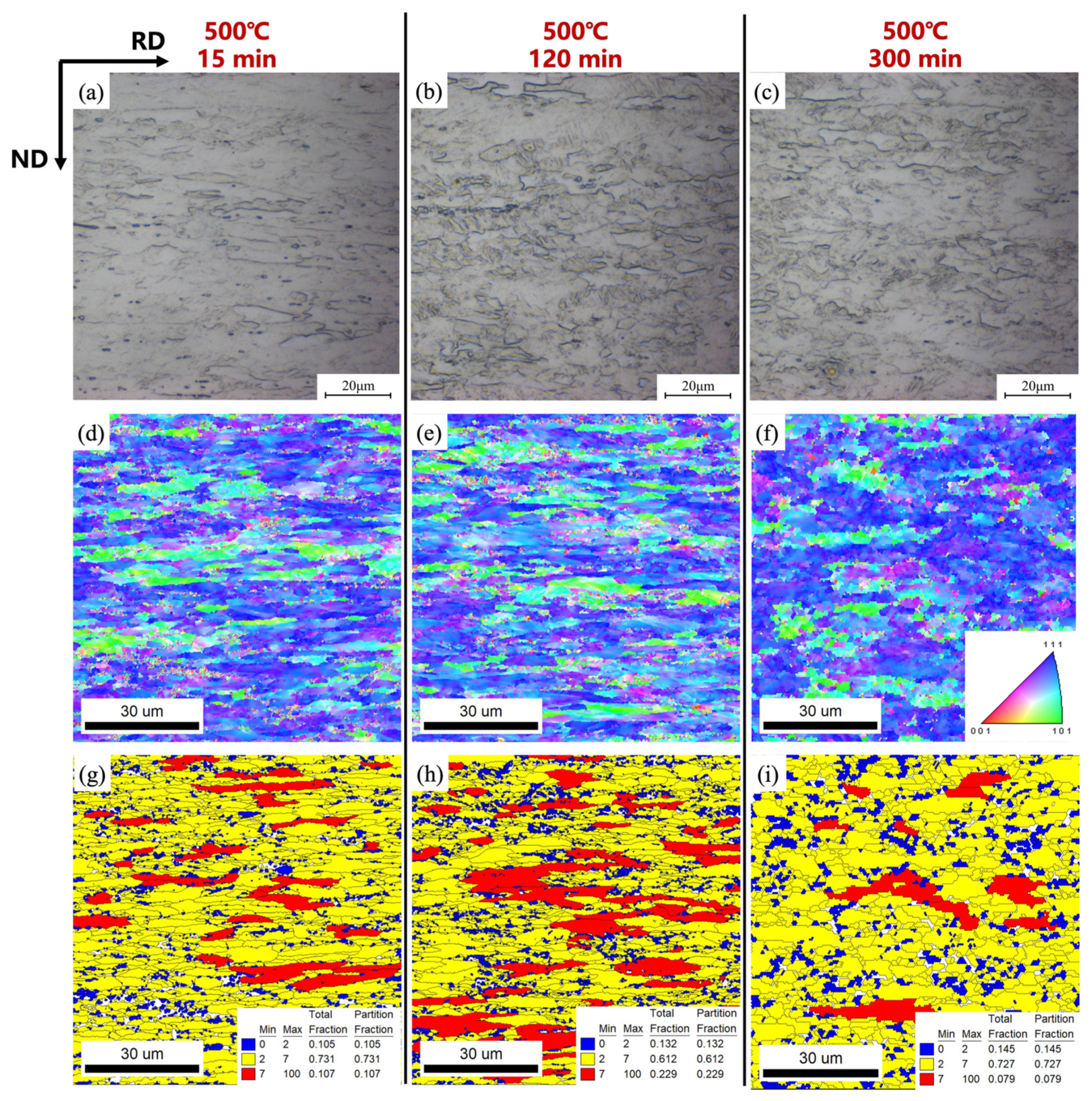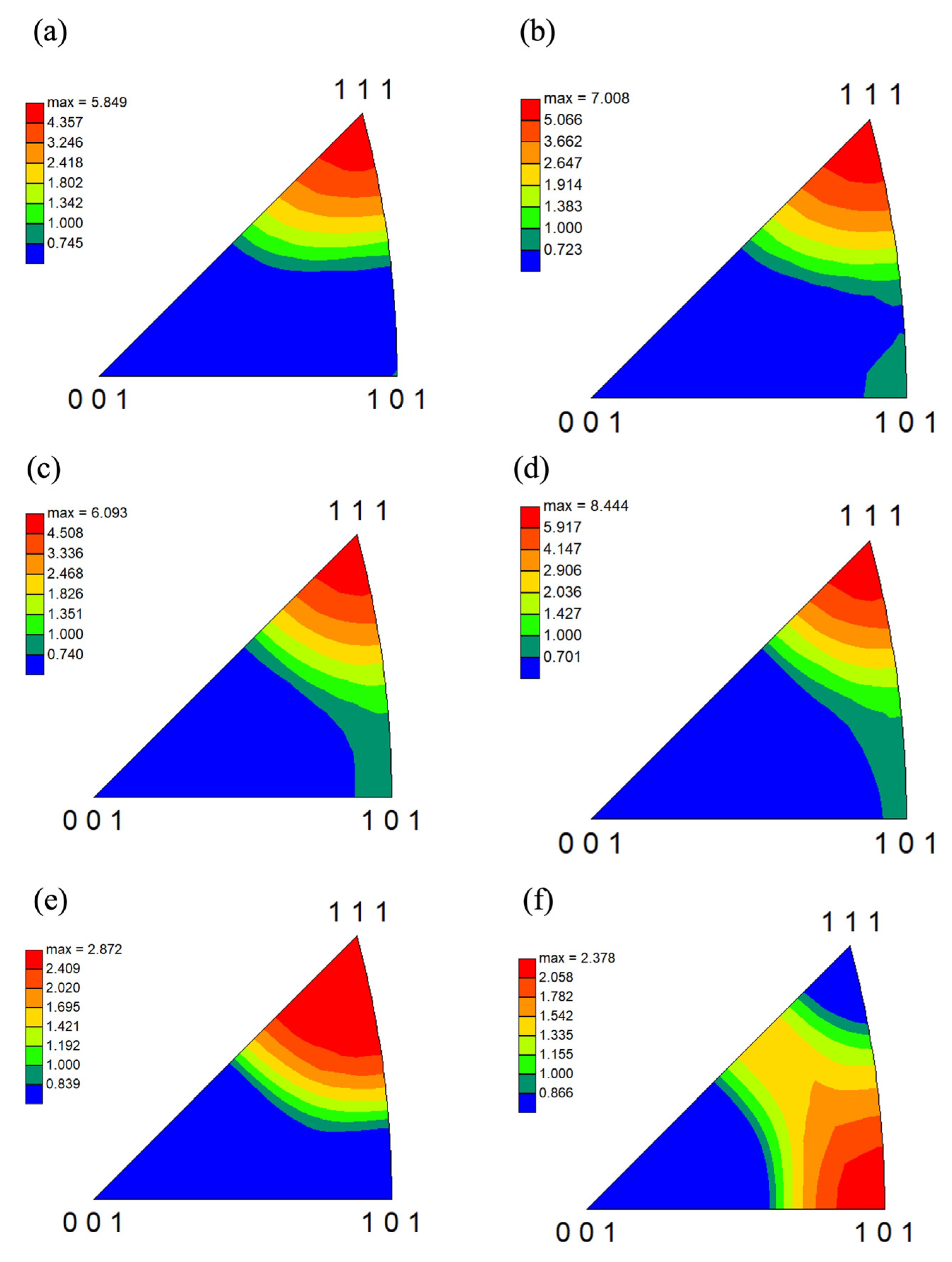Effect of Annealing on the Microstructure, Texture, and Properties of Cold-Rolled Ti50Ni47Fe3 Shape Memory Alloy Sheets
Abstract
:1. Introduction
2. Materials and Methods
3. Results and Discussion
3.1. The Effect of Annealing Treatment on the Microstructure of Ti50Ni47Fe3 Alloy
3.2. The Effect of Annealing Treatment on the Texture of Ti50Ni47Fe3 Alloy
3.3. The Effect of Annealing Treatment on Mechanical Properties of Ti50Ni47Fe3 Alloy
3.4. The Effect of Annealing Treatment on the Fracture Characteristics of Ti50Ni47Fe3 Alloy
4. Conclusions
Author Contributions
Funding
Data Availability Statement
Conflicts of Interest
References
- Mohd Jani, J.; Leary, M.; Subic, A.; Gibson, M.A. A review of shape memory alloy research, applications and opportunities. Mater. Des. 2014, 56, 1078–1113. [Google Scholar] [CrossRef]
- Velmurugan, C.; Senthilkumar, V.; Dinesh, S.; Arulkirubakaran, D. Review on phase transformation behavior of NiTi shape memory alloys. Mater. Today Proc. 2018, 5, 14597–14606. [Google Scholar] [CrossRef]
- Otsuka, K.; Ren, X. Physical metallurgy of Ti–Ni–based shape memory alloys. Prog. Mater Sci. 2005, 50, 511–678. [Google Scholar] [CrossRef]
- Cai, W.; Meng, X.L.; Zhao, L.C. Recent development of TiNi–based shape memory alloys. Curr. Opin. Solid State Mater. Sci. 2005, 9, 296–302. [Google Scholar] [CrossRef]
- Xue, P.F.; Zhang, F.; Li, Y.; Zhang, D.Y. Progress in Ti-based shape memory alloys. Chin. J. Rare Metals 2015, 39, 84–90. [Google Scholar]
- Bigelow, G.S.; Garg, A.; Padula II, S.A.; Gaydosh, D.J.; Noebe, R.D. Load-biased shape-memory and superelastic properties of a precipitation strengthened high-temperature Ni50.3Ti29.7Hf20 alloy. Scr. Mater. 2011, 64, 725–728. [Google Scholar] [CrossRef]
- Amireche, R.; Morin, M.; Belkahla, S. Study of the “All-Round-Effect” generated by aging in traction in a Ni rich TiNi shape memory alloy. J. Alloys Compd. 2012, 516, 5–8. [Google Scholar] [CrossRef]
- Ostapenko, M.G.; Semin, V.O.; D’Yachenko, F.A.; Neiman, A.A.; Meisner, L.L. Structure and residual stress distribution in TiNi substrate after fabrication of surface alloy using electron-beam treatments. Acta Mater. 2022, 231, 117893. [Google Scholar] [CrossRef]
- Otsuka, K.; Ren, X. Recent developments in the research of shape momery alloys. Intermetallics 1999, 7, 511–528. [Google Scholar] [CrossRef]
- Ouyang, X.P.; Fang, X.; Zhu, Y.; Wang, K.; Yang, H.Y. Overview of aviation hydraulic fittings. China Mech. Eng. 2015, 26, 136–145. [Google Scholar]
- Yin, X.Q.; Wang, S.J.; Li, Y.F.; Xie, H.F.; Mi, X.J. Hot deformation behavior of TiNiFe shape memory alloys. Chin. J. Rare Metals 2012, 36, 851–857. [Google Scholar]
- Piao, M.; Miyazakin, S.; Otsuka, K.; Nishida, N. Effects of Nb addition on the microstructure of Ti-Ni alloys. Mater. Trans. 1992, 33, 337–345. [Google Scholar] [CrossRef]
- Bao, Z.Z.; Guo, S.; Xiao, F.; Zhao, X.Q. Development of NiTiNb in-situ composite with high damping capacity and high yield strength. Prog. Nat. Sci. 2011, 21, 293–300. [Google Scholar] [CrossRef]
- Cai, W.; Meng, X.L.; Zhao, X.Q.; Cui, L.S.; Xu, H.B. Martensitic transformation and shape memory effect of Ti-Ni based high temperature shape memory alloys. Mater. China 2012, 31, 40–47. [Google Scholar]
- Patriarca, L.; Sehitoglu, H. High-temperature superelasticity of Ni50.6Ti24.4Hf25.0 shape memory alloy. Scr. Mater. 2015, 101, 12–15. [Google Scholar] [CrossRef]
- Pérez-Sierra, A.M.; Pons, J.; Santamarta, R.; Karaman, I.; Noebe, R.D. Stability of a Ni-rich Ni-Ti-Zr high temperature shape memory alloy upon low temperature aging and thermal cycling. Scr. Mater. 2016, 124, 47–50. [Google Scholar] [CrossRef]
- Nayan, N.; Singh, G.; Murty, S.V.S.N.; Narayan, P.R.; Mohan, M.; Venkitakrishnan, P.V.; Ramamurty, U. Effect of ternary additions of Cu and Fe on the hot deformation behavior of NiTi shape memory alloy-A study using processing maps. Intermetallics 2021, 131, 107084. [Google Scholar] [CrossRef]
- Ingale, B.D.; Wei, W.C.; Chang, P.C.; Kuo, Y.K.; Wu, S.K. Anomalous transport and thermal properties of NiTi and with Cu and Fe-doped shape memory alloys near the martensitic transition. J. Appl. Phys. 2011, 110, 113721. [Google Scholar] [CrossRef]
- Xu, Z.Y.; Jiang, B.H.; Yang, D.Z.; Zhao, L.C.; Guo, J.F.; Pan, D.C.; Xie, C.Y.; Cai, W.; Zhang, X.Q.; Huang, Y. Shape Memory Materials; Shanghai Jiao Tong University Press: Shanghai, China, 2000. [Google Scholar]
- Ji, Y.C.; Wang, D.; Ding, X.D.; Otsuka, K.; Ren, X.B. Origin of an isothermal R-martensite formation in Ni-rich Ti-Ni solid solution: Crystallization of strain glass. Phys. Rev. Lett. 2015, 114, 055701. [Google Scholar] [CrossRef]
- Zhang, Y.Q.; Jiang, S.Y.; Zhu, X.M.; Zhao, Y.N.; Liang, Y.L.; Sun, D. Influence of Fe addition on phase transformation behavior of NiTi shape memory alloy. Trans. Nonferrous Met. Soc. China 2017, 27, 1580–1587. [Google Scholar] [CrossRef]
- Naresh, H.; Bharath, H.S.; Prashantha, S. The influence of alloying constituent Fe on mechanical properties of NiTi based shape memory alloys. Mater. Today Proc. 2017, 4, 11251–11259. [Google Scholar] [CrossRef]
- Yin, X.Q.; Park, C.H.; Li, Y.F.; Ye, W.J.; Zuo, Y.T.; Lee, S.W.; Yeom, J.T.; Mi, X.J. Mechanism of continuous dynamic recrystallization in a 50Ti-47Ni-3Fe shape memory alloy during hot compressive deformation. J. Alloys Compd. 2017, 693, 426–431. [Google Scholar] [CrossRef]
- Wang, J.G.; Liu, F.S.; Cao, J.M. The microstructure and thermomechanical behavior of Ti50Ni47Fe2.5Nd0.5 shape memory alloys. Mat. Sci. Eng. A 2010, 527, 6200–6204. [Google Scholar] [CrossRef]
- Liang, Y.L.; Jiang, S.Y.; Zhang, Y.Q.; Hu, L.; Zhao, C.Z. Microstructure evolution and deformation mechanism of NiTiFe shape memory alloy based on plane strain compression and subsequent annealing. Mater. Chem. Phys. 2018, 215, 112–120. [Google Scholar] [CrossRef]
- Ma, W.; Chen, B.; Liu, F.S.; Xu, Q. Phase transformation behaviors and mechanical properties of Ti50Ni49Fe1 alloy with severe plastic deformation. Rare Metals 2013, 32, 448–452. [Google Scholar] [CrossRef]
- Okamoto, Y.; Hamanaka, H.; Miura, F.; Tamura, H.; Horikawa, H. Reversible changes in yield stress and transformation temperature of a NiTi alloy by alternate heat treatments. Scr. Met. Mater. 1988, 22, 517–520. [Google Scholar] [CrossRef]
- Abujudom, D.N.; Thoma, P.E.; Fariabi, S. The effect of cold work and heat treatment on the phase transformations of near equiatomic NiTi shape memory alloy. Mater. Sci Forum. 1991, 56–58, 565–570. [Google Scholar] [CrossRef]
- Feng, H.; He, Z.R.; Du, Q.Y.; Ye, J.J.; Zhang, K.G.; Zhang, T. Effect of annealing and deformation processes on properties of Ti-51.1Ni shape memory alloy. Trans. Mater. HeatTreatment 2019, 40, 50–55. [Google Scholar]
- Liu, S.W.; Li, Y.F.; Song, X.Y.; Yu, Y.; Ye, W.J.; Hui, S.X. Microstructures and mechanical properties of annealed Ti50Ni47Fe3 shape memory alloy. Crystals 2023, 13, 706. [Google Scholar] [CrossRef]
- Tadayyon, G.; Mazinani, M.; Guo, Y.; Zebarjad, S.M.; Tofail, S.A.M.; Biggs, M.J.P. Study of the microstructure evolution of heat treated Ti-rich NiTi shape memory alloy. Mater. Charact. 2016, 112, 11–19. [Google Scholar] [CrossRef]
- Tadayyon, G.; Mazinani, M.; Guo, Y.; Zebarjad, S.M.; Tofail, S.A.M.; Biggs, M.J.P. The effect of annealing on the mechanical properties and microstructural evolution of Ti-rich NiTi shape memory alloy. Mater. Sci. Eng. A 2016, 662, 564–577. [Google Scholar] [CrossRef]
- Tadayyon, G.; Guo, Y.; Mazinani, M.; Zebarjad, S.M.; Tiernan, P.; Tofail, S.A.M.; Biggs, M.J.P. Effect of different stages of deformation on the microstructure evolution of Ti-rich NiTi shape memory alloy. Mater. Charact. 2017, 125, 51–56. [Google Scholar] [CrossRef]
- Pandolfi, G.S.; Martins, S.C.; Buono, V.T.L.; Santos, L.A. Precipitation kinetics of Ti3Ni4 and multistage martensitic transformation in an aged Ni-rich Ni-Ti shape memory alloy. J. Mater. Res. Technol. 2020, 9, 9162–9173. [Google Scholar] [CrossRef]
- Yuan, X.B.; Chen, B.; Liu, F.S.; Xu, Q.; Ma, W. Transformation behaviors and superelasticity of Ti50Ni48Fe2 shape memory alloy subjected to cold-rolling and subsequent annealing. Rare Metals 2014, 33, 652–656. [Google Scholar] [CrossRef]
- Liu, Y.; Liu, F.S. Transformation behaviors of Ti48.5Ni48Fe2Nb1.5 dependence of annealing and thermomechanical cycling. Rare Metals 2012, 31, 231–236. [Google Scholar] [CrossRef]
- Su, P. The four-step multiple stage transformation in deformed and annealed Ti49Ni51 shape memory alloy. Acta Mater. 2012, 31, 231–236. [Google Scholar] [CrossRef]
- Chang, S.; Wu, S.; Chang, G. Grain size effect on multiple-stage transformations of a cold-rolled and annealed equiatomic TiNi alloy. Scr. Mater. 2005, 52, 1341–1346. [Google Scholar] [CrossRef]
- Yoo, K.I.; Kim, Y.J.; Shin, D.K.; Lee, J.J. Development of martensite transformation kinetics of NiTi shape memory alloys under compression. Int. J. Solids Struct. 2015, 64–65, 51–61. [Google Scholar] [CrossRef]
- Yan, X.J.; Van Humbeeck, J. Influence of pre-strain on recovery stress of annealed NiTi thin wire during isothermal holding. J. Alloys Compd. 2011, 509, 1001–1006. [Google Scholar] [CrossRef]
- Poletika, T.K.; Girsova, S.L.; Lotkov, A.I. Ti3Ni4 precipitation features in heat-treated grain/subgrain nanostructure in Ni-rich TiNi alloy. Intermetallics 2020, 127, 106966. [Google Scholar] [CrossRef]
- Liu, S.W.; Hui, S.X.; Li, Y.F.; Song, X.Y.; Yu, Y.; Ye, W.J. equivalent heat treatments and mechanical properties in cold-rolled TiNiFe shape-memory alloys. Materials 2023, 16, 7395. [Google Scholar] [CrossRef] [PubMed]










| Element | Fe | Ni | C | O | Ti |
|---|---|---|---|---|---|
| Content (wt.%) | 3.27 | 52.16 | 0.028 | 0.031 | Bal. |
Disclaimer/Publisher’s Note: The statements, opinions and data contained in all publications are solely those of the individual author(s) and contributor(s) and not of MDPI and/or the editor(s). MDPI and/or the editor(s) disclaim responsibility for any injury to people or property resulting from any ideas, methods, instructions or products referred to in the content. |
© 2024 by the authors. Licensee MDPI, Basel, Switzerland. This article is an open access article distributed under the terms and conditions of the Creative Commons Attribution (CC BY) license (https://creativecommons.org/licenses/by/4.0/).
Share and Cite
Liu, S.; Song, X.; Li, Y.; Yu, Y.; Ye, W.; Hui, S. Effect of Annealing on the Microstructure, Texture, and Properties of Cold-Rolled Ti50Ni47Fe3 Shape Memory Alloy Sheets. Crystals 2024, 14, 360. https://doi.org/10.3390/cryst14040360
Liu S, Song X, Li Y, Yu Y, Ye W, Hui S. Effect of Annealing on the Microstructure, Texture, and Properties of Cold-Rolled Ti50Ni47Fe3 Shape Memory Alloy Sheets. Crystals. 2024; 14(4):360. https://doi.org/10.3390/cryst14040360
Chicago/Turabian StyleLiu, Shuwei, Xiaoyun Song, Yanfeng Li, Yang Yu, Wenjun Ye, and Songxiao Hui. 2024. "Effect of Annealing on the Microstructure, Texture, and Properties of Cold-Rolled Ti50Ni47Fe3 Shape Memory Alloy Sheets" Crystals 14, no. 4: 360. https://doi.org/10.3390/cryst14040360





